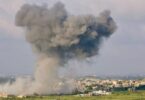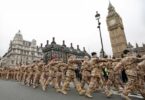Bradley Bowman / Maj. Lauren Harrison / Ryan Brobst
Defeating adversaries in the future will require the U.S. military to detect and strike targets more quickly than its opponents can. The E-3 Sentry Airborne Warning and Control System (AWACS) plays a pivotal role in this sequence of activities known as closing the “kill chain.” The E-3, however, is increasingly outdated and outmatched — requiring urgent replacement.
Ideally, the Air Force could immediately begin a transition from the E-3 to space-based airborne moving target indicator (AMTI) capabilities. That could potentially provide a persistent, near global, and more survivable means to sense, track, and identify air targets.
The reality, however, is that such a space-based solution is not “mature” — that’s Pentagon-speak for we don’t have the ability to do that yet.
Given the dire condition of the E-3 and the fact Russia and China are sprinting to field their own advanced versions of the aircraft means that the U.S. needs a “bridging” solution — an aircraft that could enable the retirement of the E-3 and fulfill its vital mission at least until space-based capabilities come online. Such a solution could perhaps include the rapid acquisition of the Boeing 737-based E-7 Wedgetail or the Gulfstream 550 version flown by Israel and Italy.
Regardless, the E-3 must be replaced — and fast. Perhaps that is why Air Force Chief of Staff Gen. Charles Brown Jr. announced last week that the service is conducting an “internal analysis” to develop options for doing just that.
A Critical Role At A Critical Time
The E-3 is a modified Boeing 707 commercial airframe that entered service in the 1970s and is equipped with a large rotating dome that houses radar and identification friend or foe (IFF) antennas. These sensors, along with a passive detection system, enable identification of air and maritime assets at a range of over 250 miles.
The crew consists of four flight crew members and 13 to 19 mission crew members, which include air battle managers (ABMs) and technicians. Armed with a real-time view of the operating area, the ABMs onboard the E-3 communicate early-warning and surveillance information to senior leaders while providing tactical command and control (C2) to friendly forces. This C2 function includes orienting fighters and bombers, pairing them to targets, and accelerating accurate decision-making.
In any potential conflict with China or Russia, the military force that completes that chain of actions quickest will prevail. For the United States that will likely require sharing information seamlessly with allies and partners fighting at its side. Tactical C2 is particularly important in a coalition environment.
During the 2011 Operation Odyssey Dawn in Libya, for example, the AWACS was not present until after strike operations had already begun. As a result, individual nations routed communications through their own channels, causing substantial delays in targeting. Once airborne C2 was in place, however, U.S. forces reduced the time required to close the kill chain from 20 minutes to mere seconds.
That will likely be the difference between life and death for American and allied forces in future conflicts.
AWACS also add resilience to the C2 structure in an anti-access, area-denial environment. In such environments, C2 capabilities are limited by long-range missiles that threaten planning and operations centers, while denial of space-based communications, navigation, and intelligence, coupled with cyberattacks and electronic warfare, threatens to blind forces.
As reflected in the 2021 update to Air Force doctrine, this increasingly contested environment puts a premium on resilient, redundant, and distributed C2 capabilities. The AWACS provides just that. The AWACS can adjust its position to optimize connectivity, coverage, and survivability, providing redundant communications through line-of-sight radios and secure networks. It can also act as a backup if vulnerable, ground-based operations centers are incapacitated or destroyed.
Why The E-3 Is No Longer Up To The Task
As critical as the capability is, last month Gen. Mark Kelly, the commander of Air Combat Command, said his top intelligence, surveillance, and reconnaissance modernization priority was replacing the AWACS.
It is easy to see why.
The E-3 fleet’s average age is over 40 years old. Air Force maintenance personnel have worked miracles to sustain the aging aircraft, which has been out of production for decades and suffers from cold engine supply chains, fatigue damage, and corrosion. The Air Force says the E-3’s availability rate is a miserable 40%.
“We are in the single-digit number of years before that airplane votes with its wings and votes with its metal structure that it’s just not viable to operate and sustain any longer,” Kelly said.
Constant modifications to keep the AWACS airborne decrease its availability and come at a cost. By 2025, upgrades to communication and networking equipment will have cost nearly $2 billion, while cockpit modifications to keep the aircraft compliant with Federal Aviation Administration navigation requirements will cost roughly $1.4 billion, with an estimated completion date of 2027. If an alternative to the E-3 is available, those expenditures seem particularly wasteful given the E-3’s planned retirement in 2035. Regardless, these patches will matter little if the ongoing problems with the fuel system, landing gear, air frame, pressurization, and engines keep the aircraft grounded.
Unfortunately, the problems with the E-3 do not stop there.
AWACS operators face significant hurdles in carrying out their mission. As Kelly noted, the E-3 does not have cutting-edge AMTI like the platforms used by U.S. allies such as Australia, South Korea, and soon the United Kingdom, which operate the E-7 Wedgetail.
Even more concerning, China and Russia are preparing to field fifth-generation AWACS that will reportedly have enhanced capabilities.
“The fact is,” the head of U.S. Pacific Air Forces, Gen. Kenneth Wilsbach, warned earlier this year, “we actually need something relatively quick because of the reliability of the E-3.”
If the Air Force chooses a “bridging” solution such as the E-7 or the G550, the service will need to manage the E-3 divestment and new aircraft acquisition timeline carefully to avoid dangerous gaps just at a moment when Chinese and Russian capabilities are becoming increasingly formidable.
That will be easier said than done. It is expensive to maintain a four-decade old fleet of aircraft and simultaneously acquire expensive new capabilities.
Regardless, given the poor condition of the E-3, growing threats to U.S. and allied forces, and the importance of the AMTI mission, there is no time to waste.
Bradley Bowman is senior director of the Center on Military and Political Power at the Foundation for Defense of Democracies. Maj. Lauren Harrison is an Air Force officer, E-3 instructor pilot, and visiting military analyst at FDD, where Ryan Brobst is a research analyst. The views expressed in this commentary are those of the authors and do not necessarily represent the views of the Defense Department or the Air Force. Follow Bradley on Twitter @Brad_L_Bowman. FDD is a Washington, DC-based, non-partisan research institute focusing on national security and foreign policy.
Courtesy: (FDD)






